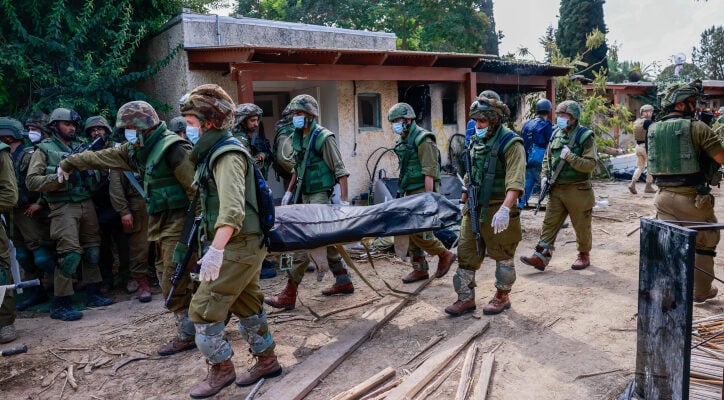In total, we saw 138 dead bodies — less than 10 percent of the overall death toll, as the Israel Defense Forces (IDF) officer who introduced the footage was careful to point out.
By Ben Cohen, The Algemeiner
During his visit to Israel on Friday, US Secretary of State Antony Blinken lamented that the memory of the Hamas pogrom in southern Israel less than one month ago is fading.
“It is striking and in some ways shocking that the brutality of the slaughter has receded so quickly in the memories of so many,” Blinken said at a press conference in Tel Aviv. “But not in Israel, and not in America. Thirty-five Americans were murdered that day as well, and more than 200 foreign nationals from 35 countries.”
It wasn’t clear whose memories Blinken was referring to, but perhaps he had in mind the hundreds of thousands of demonstrators who have taken to the streets of cities around the world falsely claiming that Israel’s defensive war in Gaza is a genocide, along with those who have made a mission of tearing down wall posters publicizing the fate of the hostages seized by Hamas. Or the UN diplomats who last week passed a General Assembly resolution demanding an immediate ceasefire but not even acknowledging the atrocities of Oct. 7.
There is an associated argument that if such people only knew the truth — if they only understood the scale of the brutality on that black day, and the sheer joy experienced by those who executed it — their opinions would shift.
Hesitantly and perhaps a little haphazardly, the Israeli government is currently organizing screenings for journalists in several cities to view uncensored footage of the atrocities so that we can see the nature of Hamas with our own eyes. The footage was shown in Israel last week, first to a group of journalists and then to members of the Knesset, some of whom fled the room in tears at what they saw.
On Friday, it was the turn of those of us in New York City to witness the 45-minute collage of images gathered from bodycams worn by the Hamas terrorists — from Dash Cams positioned in cars, from CCTV in the assaulted communities in southern Israel, and from the cellphone videos captured by shocked emergency workers arriving at the scenes of carnage. In total, we saw 138 dead bodies — less than 10 percent of the overall death toll, as the Israel Defense Forces (IDF) officer who introduced the footage was careful to point out.
What I saw chimed with the earlier accounts of journalists who saw the footage. It was by turns revolting, heartbreaking, and enraging, and it left you wondering about the seemingly endless capacity of human beings to engage in cruelty.
One of the episodes shown in the video has been widely reported on: a father and his two sons who fled into the garden of their home on Moshav Netiv HaAsara, wearing their underpants and nothing else. The father is brutally shot dead in front of his children who are showered with his blood. In the next scenes, we see and hear the two boys, one of whom has been blinded in one eye by the attack, begging for their mother, weeping for their father, and wishing they were dead. In the midst of all this misery, a Hamas terrorist enters and casually opens the fridge, taking a swig from a bottle of Coke while the two boys, barely in their adolescence, cry uncontrollably.
Then there is the group of girls, in their late teens, cowering in a shelter as the sound of gunfire grows closer and their anguish deepens. In this scene too, another Hamas terrorist enters, standing over the girls ominously. As we watch this unfold, one of the Israeli officials tells us that most of the girls were executed, but some were kept alive for the purposes of rape. Again, sheer cruelty reminiscent — as Gilad Erdan, Israel’s Ambassador to the UN told us — of the worst excesses of ISIS or the Nigerian Islamist terrorists of Boko Haram.
And of course, there are the pictures of dead infants, some burned so badly that all that was left was a small, blackened torso. Those images, once seen, can never be unseen.
When I told a family member on Friday morning that I was going to see the video, he asked me what the point of the exercise was. Since we were not allowed to record any of the images we saw, and permitted only to report on them narratively, how would we ever get to a point where the facts of the Hamas atrocities are undisputed? Conversely, if the images were released to the general public, would that not violate the privacy and the grieving of surviving relatives?
These are pertinent questions, and I confess that I don’t have a complete answer. Part of the response is what Blinken described — that the memory of Oct. 7 is disappearing, superseded by more recent events, particularly the heavy bombing of Gaza by the IDF. Showing these images to journalists and diplomats — people who, theoretically at least, can influence public discourse — keeps the memory alive as well as serving as a reminder of why Israel has turned to military force.
The experience of dealing with Holocaust denial should give us pause here. The Holocaust was, by the standards of the time, copiously recorded through photographs, some film, and a sea of documents maintained by the Nazis. So, if our methodology is purely empirical, then Holocaust denial can only be dismissed as absurd. But conspiracy theories are powerful, offering alternative explanations for the images before us. They were fabricated, or inaccurately represented, or lifted from a conflict somewhere else — any argument will do, so long as it arrives at the conclusion that Hamas didn’t burn babies, didn’t rape young women as they tried, desperately, to escape a rave in the Negev desert by running across flat terrain that left them completely exposed to gunfire, didn’t murder disabled and elderly individuals because carting them back to Gaza as hostages was too much trouble logistically.
There is another purpose to these images besides preserving the memory of the 1,400 Israelis and foreigners — 35 nationalities in all — butchered on Oct. 7. And that is, as the Israeli officials pointed out, to eradicate Hamas and its infrastructure from Gaza, for, as Erdan argued, one massacre is not an existential challenge for Israel, but a second one would absolutely be.
Yet again, we are saying “Never Again.”





